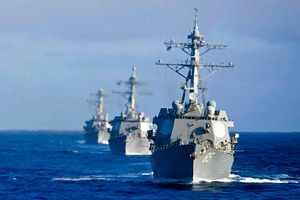The United States Navy and the Japan Maritime Self-Defense Force (JMSDF) are conducting a bilateral naval drill, dubbed MultiSail 2017, off the U.S.-owned island of Guam in the northwestern Pacific Ocean from March 6-10, according to a U.S. Navy press release.
The U.S. Navy has dispatched a total of six surface warships including the Arleigh Burke-class destroyers USS Stethem, USS Barry, USS Mustin, USS Fitzgerald, and USS McCampbell, as well as a Ticonderoga-class guided missile cruiser. The JMSDF is participating with two guided-missile destroyers. In addition, both navies have also sent number of subsurface and other special units.
“MultiSail is a bilateral training exercise which improves interoperability between U.S. and Japanese forces. This training provides real-world proficiency through detecting, locating, tracking, and engaging units at sea, in the air, on land, and underwater in response to a range of mission areas,” according to the U.S. Navy statement. “This year’s exercise will include in-port and at-sea training by Naval Surface and Mine Warfighting Development Center.”
The MultiSail training exercise was first held as a pre-deployment training exercise, but has expanded in scope in subsequent years to bilateral naval drill in which both navies are testing some of the latest equipment, tactics, and procedures. “The participating forces will exercise a wide range of capabilities and demonstrate the inherent flexibility of our combined forces. These capabilities range from maritime security operations to more complex anti-submarine and air defense exercises,” the U.S. Navy statement reads.
The exercise “benefits from realistic, shared training scenarios which enhance the ability to work together to confront any contingency,” the statement continues. “MultiSail prepares forces which will provide the deterrence and stabilizing effects of a force-in-being, ready at the outset of a contingency without delays for build-ups or extensive mission rehearsal.” As I reportedly previously, in December 2016, Japan adopted new guidelines that now permits JMSDF ships to protect U.S. Navy vessels.
The United States and Japan also concluded a month-long amphibious warfare exercise held at Camp Pendleton and San Clemente Island in southern California on March 6.
Furthermore, the U.S. Navy and JMSDF are currently participating in the annual U.S.-led Pacific Partnership mission, the largest annual multilateral humanitarian assistance and disaster relief (HA/DR) preparedness exercise conducted in the Asia-Pacific region. HA/DR teams from Australia, the United States, the United Kingdom, Japan and South Korea are training with this year’s host nations — Sri Lanka, Malaysia and Vietnam — for humanitarian assistance and disaster response missions.

































